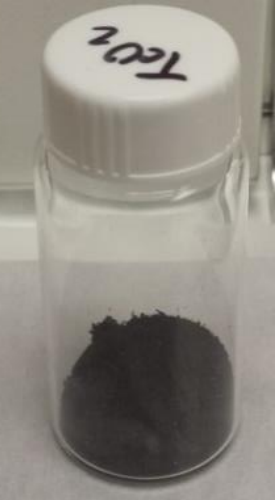Group 7 element





Group 7 elements are a group of chemical elements in the periodic table. They are located in column 7 (or VII) of the periodic table and consist of manganese (Mn), technetium (Tc), and rhenium (Re). These elements are part of the d-block of the periodic table, which means they are transition metals. The group 7 elements share similar physical and chemical properties, including high melting points, and they are known for their complex chemistry, especially in oxidation states ranging from -1 to +7.
Properties[edit]
The group 7 elements exhibit a wide range of physical and chemical properties but share some common characteristics. Manganese, the lightest group 7 element, is a hard and brittle metal. Technetium, the element below manganese, is radioactive and has no stable isotopes. Rhenium, the heaviest, is a high-melting, dense metal. These elements often display several oxidation states, with +7 being the most common and stable for technetium and rhenium, while manganese exhibits a wide range, from -3 to +7.
Occurrence[edit]
Manganese is the only element in group 7 that is found abundantly in the Earth's crust. It is extracted from various minerals, with pyrolusite (MnO2) being the most significant manganese ore. Technetium and rhenium are much rarer. Technetium, being radioactive, is predominantly produced in nuclear reactors, while rhenium is obtained as a by-product of molybdenum refining.
Applications[edit]
Group 7 elements have diverse applications. Manganese is crucial in steel production, acting as a deoxidizer and alloying agent. It is also used in batteries and pigments. Technetium's radioactive properties make it useful in nuclear medicine for diagnostic tests. Rhenium has a high melting point and is used in high-temperature superalloys for jet engines, as well as in catalysts for the petroleum industry.
Chemical Reactions[edit]
The chemistry of group 7 elements is complex and varied. Manganese compounds, for example, can exist in oxidation states from -3 to +7, making it extremely versatile in chemical reactions. Technetium, primarily in the +7 oxidation state, forms pertechnetate (TcO4^-), which is similar to permanganate (MnO4^-) but is used in nuclear medicine. Rhenium also exhibits a +7 oxidation state, forming similar compounds to technetium and manganese.
Health and Environmental Aspects[edit]
Manganese is an essential nutrient for humans, but excessive exposure can lead to neurological problems. Technetium, being radioactive, poses health risks associated with radiation exposure. Rhenium has no known biological role but is considered to have low toxicity.
See Also[edit]
![]()
This chemical element related article is a stub. You can help WikiMD by expanding it.
Ad. Transform your life with W8MD's Budget GLP-1 injections from $75


W8MD offers a medical weight loss program to lose weight in Philadelphia. Our physician-supervised medical weight loss provides:
- Weight loss injections in NYC (generic and brand names):
- Zepbound / Mounjaro, Wegovy / Ozempic, Saxenda
- Most insurances accepted or discounted self-pay rates. We will obtain insurance prior authorizations if needed.
- Generic GLP1 weight loss injections from $75 for the starting dose.
- Also offer prescription weight loss medications including Phentermine, Qsymia, Diethylpropion, Contrave etc.
NYC weight loss doctor appointmentsNYC weight loss doctor appointments
Start your NYC weight loss journey today at our NYC medical weight loss and Philadelphia medical weight loss clinics.
- Call 718-946-5500 to lose weight in NYC or for medical weight loss in Philadelphia 215-676-2334.
- Tags:NYC medical weight loss, Philadelphia lose weight Zepbound NYC, Budget GLP1 weight loss injections, Wegovy Philadelphia, Wegovy NYC, Philadelphia medical weight loss, Brookly weight loss and Wegovy NYC
|
WikiMD's Wellness Encyclopedia |
| Let Food Be Thy Medicine Medicine Thy Food - Hippocrates |
Medical Disclaimer: WikiMD is not a substitute for professional medical advice. The information on WikiMD is provided as an information resource only, may be incorrect, outdated or misleading, and is not to be used or relied on for any diagnostic or treatment purposes. Please consult your health care provider before making any healthcare decisions or for guidance about a specific medical condition. WikiMD expressly disclaims responsibility, and shall have no liability, for any damages, loss, injury, or liability whatsoever suffered as a result of your reliance on the information contained in this site. By visiting this site you agree to the foregoing terms and conditions, which may from time to time be changed or supplemented by WikiMD. If you do not agree to the foregoing terms and conditions, you should not enter or use this site. See full disclaimer.
Credits:Most images are courtesy of Wikimedia commons, and templates, categories Wikipedia, licensed under CC BY SA or similar.
Translate this page: - East Asian
中文,
日本,
한국어,
South Asian
हिन्दी,
தமிழ்,
తెలుగు,
Urdu,
ಕನ್ನಡ,
Southeast Asian
Indonesian,
Vietnamese,
Thai,
မြန်မာဘာသာ,
বাংলা
European
español,
Deutsch,
français,
Greek,
português do Brasil,
polski,
română,
русский,
Nederlands,
norsk,
svenska,
suomi,
Italian
Middle Eastern & African
عربى,
Turkish,
Persian,
Hebrew,
Afrikaans,
isiZulu,
Kiswahili,
Other
Bulgarian,
Hungarian,
Czech,
Swedish,
മലയാളം,
मराठी,
ਪੰਜਾਬੀ,
ગુજરાતી,
Portuguese,
Ukrainian